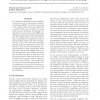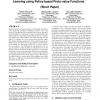124 search results - page 5 / 25 » Basis function construction for hierarchical reinforcement l... |
IWANN
1999
Springer
13 years 12 months ago
1999
Springer
To avoid the curse of dimensionality, function approximators are used in reinforcement learning to learn value functions for individual states. In order to make better use of comp...
PKDD
2009
Springer
14 years 2 months ago
2009
Springer
Abstract. Innovations such as optimistic exploration, function approximation, and hierarchical decomposition have helped scale reinforcement learning to more complex environments, ...
CG
2006
Springer
13 years 9 months ago
2006
Springer
Temporal difference (TD) learning has been used to learn strong evaluation functions in a variety of two-player games. TD-gammon illustrated how the combination of game tree search...
ICML
2002
IEEE
14 years 8 months ago
2002
IEEE
Two notions of optimality have been explored in previous work on hierarchical reinforcement learning (HRL): hierarchical optimality, or the optimal policy in the space defined by ...
ATAL
2008
Springer
13 years 9 months ago
2008
Springer
Reinforcement Learning research is traditionally devoted to solve single-task problems. Therefore, anytime a new task is faced, learning must be restarted from scratch. Recently, ...


